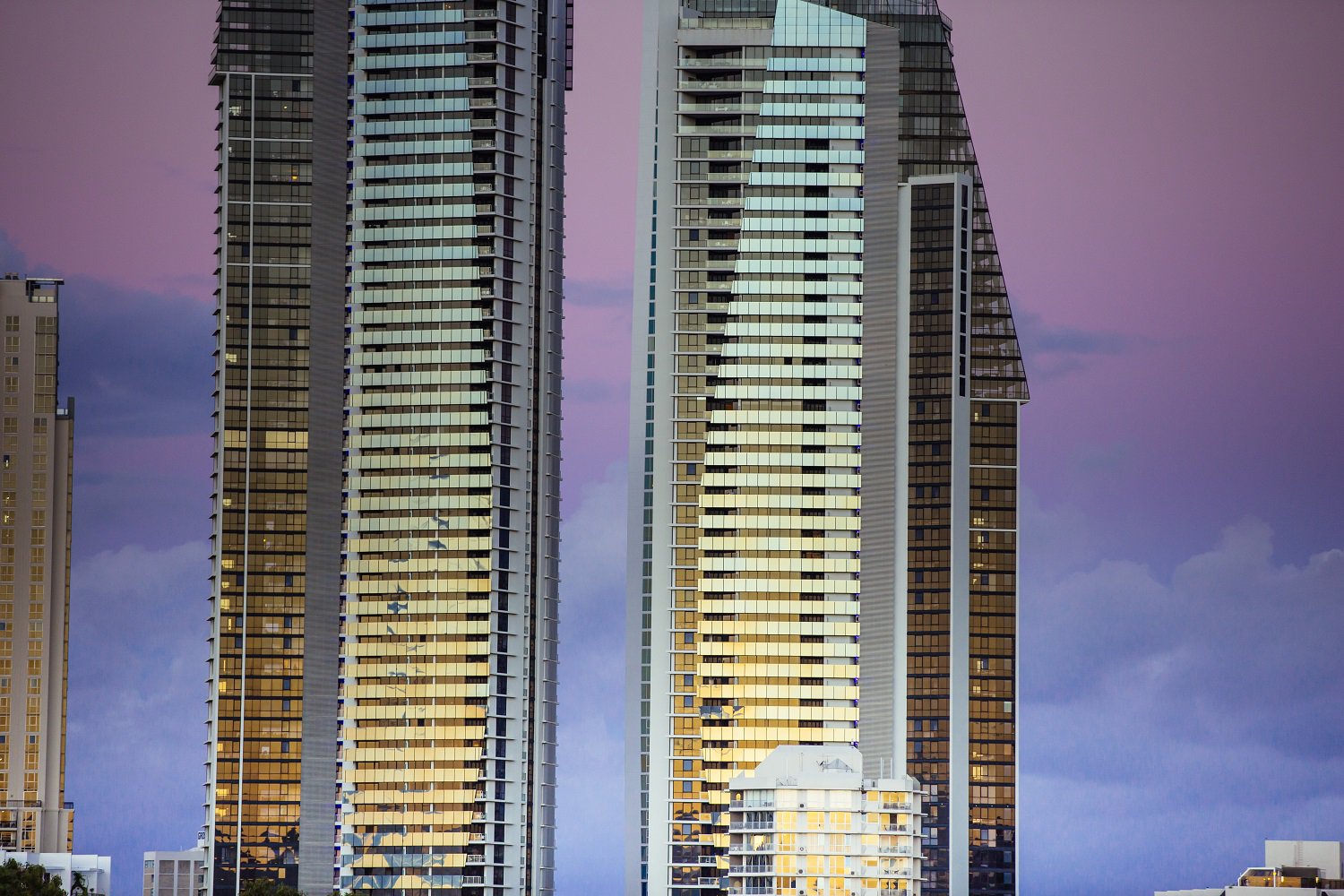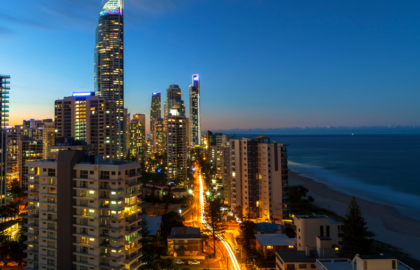
There’s no denying the Gold Coast property market is running hot at the moment, but where are the opportunities and will it last?
A decade after the last boom, the Gold Coast property market is finally hitting its stride driven by what many analysts describe as strong fundamentals.
Despite concerns of oversupply in some metropolitan markets, Tim Lawless, the research director at CoreLogic, is confident the latest recovery in Australia’s tourism capital has legs. Lawless has dismissed any suggestions that the market has all the hallmarks of the heady boom of 2007 which spectacularly unraveled during the GFC. Instead, he describes the national property market as much more complex and diverse than ever before and that the Gold Coast is just adding to that diversity.
The Gold Coast finished 2016 as one of the strongest regional property markets in Queensland. According to CoreLogic, Gold Coast property prices have been rising since 2013, with median house prices in the past year alone up about 7%. “Gold Coast adds to the complexity and diversity of the Australian market because it has been a market that has been underperforming up until the last couple of years,” says Lawless.
He says the Gold Coast was among many coastal lifestyle markets that weakened during the GFC, and the oversupply of apartments weighed heavily on the property sector for some time. “All that pain is well and truly past the Gold Coast now. We’re seeing values rising by about 6% per annum and we’re seeing transaction numbers rising. It’s not quite where they were in 2007 but still a long way off the weak levels from 2008 to 2013.”
One of the key drivers for the Gold Coast property market is the growing price gap with Sydney and Melbourne markets. CoreLogic data shows Sydney’s median house price rising 9% in 2016 to $1.028 million, while apartments rose 6.2% to $737,334. The median price of Gold Coast houses in the year to December rose 7% to $594,065 and apartment values lifted 5.7% to $389,213. However, the five-year gains are more dramatic for Sydney where the median house price has jumped 71.5% and 54.7% for apartments. On the Gold Coast the equivalent gains were 27.2% and 16.9% respectively. The median price difference for houses between Sydney and the Gold Coast is now 42%. Lawless says prior to the GFC, big gains in Gold Coast property prices narrowed that gap to just 10%.
Our very own John Newlands, REIQ Gold Coast chairman, says while the price gap with southern markets has been a traditional driver of the Gold Coast property cycle, a tight residential vacancy rate of 0.9 per cent is also fuelling demand. “Our vacancy rate at the moment is very low,” says Newlands. “We’ve had a lot of people returning here after the exodus during the GFC. They’re coming back in big numbers because there are now jobs for them.”
Employment has been driven by more than $10 billion in infrastructure and private development spending across the Gold Coast in recent years, including stage two of the light rail system, the athletes’ village and venues for the 2018 Gold Coast Commonwealth Games, the Pacific Fair and Jupiters Casino upgrades and the proposed $300 million expansion of Gold Coast Airport. This has prompted a surge in construction across the city, and led to a record number of development applications lodged with the City of Gold Coast in 2016.
Lawless is not surprised by growing developer interest in the Gold Coast, but he also notes that this is unlikely to lead to a repeat of the property crash that unfolded in 2008. “The Gold Coast is obviously a very cyclical market and we’ve seen this time and time again. As the market improves it’s natural for there to be a high level of developer confidence. A big part of the weakness of 2008 was the fact that we saw quite a severe downturn in tourism, a high Aussie dollar, and also a fairly significant downturn in lifestyle property demand. In fact we saw a lot of people trying to sell their lifestyle properties because they saw such an erosion of their wealth during the GFC that they had no choice . It was really that combination of effects that resulted in a soft market from 2008 to only just recently in the last two years. If we are going to see a repeat performance we’re going to need another catalyst that’s really a mixture of all those elements to dampen market conditions. I don’t see that happening.”
Gold Coast tourism numbers continue to rise, with records being broken by the inbound market. Tourism Australia revealed in December that 1.014 million international travellers visited the Gold Coast in the 12 months to the end of September, up 16.2 per cent on the previous year. The gains were led by Chinese tourists and supported by the weaker Australian dollar.
However, as the property market continues to be peppered with talk of an oversupply, particularly high rise apartments in Brisbane and Melbourne, property researcher Urbis sees little evidence of this on the Gold Coast. Senior researcher at Urbis, Lynda Campbell, says the current high rise development cycle lacks the ‘frenzy’ witnessed in the lead-up to 2008. She also describes the Gold Coast as the most balanced apartment market in Australia. “It is a much more controlled market,” she says, highlighting a higher degree of caution within the industry. “I believe developers and marketing agents are doing a lot more planning and research to make sure they have the right product and target the right markets for their project.” Campbell’s research has shown supply and demand for Gold Coast apartments rising in tandem over the past two years, with the 2016 September quarter recording the highest volume of new apartment sales since the GFC.
The Urbis Gold Coast Apartment Essentials report for the September quarter has revealed there were 496 apartment sales during the period, up from 304 in the June quarter. Sales for the year totalled 1375 apartments, leaving a little over a year’s supply of new apartments. “I think the market still has some legs and don’t believe we have reached a peak yet – maybe later this year,” says Campbell.
Urbis says sales growth has been achieved despite a fall in offshore buyer activity. Newlands agrees. He says that while foreign buyers have been active across the Gold Coast market, it is still largely being driven by buyers from south-east Queensland, as well as Sydney and Melbourne. Newlands still holds some concerns over the number of apartments proposed for the Gold Coast, but he sees the housing market holding up well due to limited land supply across the city.
Newlands identifies the growth corridor from Broadbeach to Helensvale as the markets to watch in 2017, with Helensvale buoyed by the light rail extension currently under construction. Burleigh and Mermaid Beach are also in the mix, he says, along with waterfront homes due to limited supply. “Pockets of Southport offer new opportunities where there is rezoning potential for older, original properties,” he says. Newlands also identifies Carrara as an emerging star in the west. “It’s accessible and affordable, so demand has been strong in this area as well. Carrara is a good example of an average suburb that is starting to come into its own simply because of where it is.”
Over the past few years, Urbis has noted coastal fringe areas such as Bundall, Ashmore and Benowa as the new development hotspots for apartments. However, Campbell sees a shortage of apartments along the southern beaches, from Palm Beach to Coolangatta, as a future opportunity for buyers. “This has been the most under-supplied new apartment market for some time,” she says. “Any new projects to enter the market in this precinct have been well received as demand is strong.”
Lawless says coastal areas offer the best opportunity for price growth in 2017, driven by an increase in ‘sea changers’. “We’re seeing those (interstate) retirees that are looking for coastal markets and lifestyle markets very much active again because they have seen their wealth rebuilt largely through equity. Those blue-chip markets that have a combination of being close to the water and close to amenities will always be attractive. Areas that may underperform will tend to be those markets where land supply is still quite substantial, such as Coomera and that area between Gold Coast and Brisbane. But areas such as Broadbeach, Palm Beach, Main Beach and through to Hope Island are always going to be in high demand because there is an inherent scarcity of land. I think they will be the markets most in demand,” says Lawless.
Looking beyond the 2018 Commonwealth Games, Campbell is expecting continued strength in the Gold Coast apartment market as the city gains an unprecedented level of international exposure. “I think this will create another up-lift in the property market and also tourism markets. How long this last remains to be seen. I hope the Commonwealth Games does for the Gold Coast what Expo 88 did for Brisbane in 1988,” she says.
Matthew Schneider, planning director at Urbis Gold Coast, says government support beyond the Games is vital to maintain industry confidence. “The Gold Coast is rapidly maturing as a city and support for the delivery of city-shaping infrastructure like the Gold Coast light rail – from government at all levels, industry and the community – can provide an important foundation for strength in the market beyond 2018,” he says.
For full article click here
Credit Nick Nichols
Please remember to keep us in mind for all of your buying, selling, renting or property management needs – you can make contact via the following means:
Drop in: 2 Elkhorn Avenue, Surfers Paradise QLD 4217
Phone: 07 5592 1464
Email: jnewlands@professionals.com.au
Website: http://professionalssurfersparadise.com.au/








